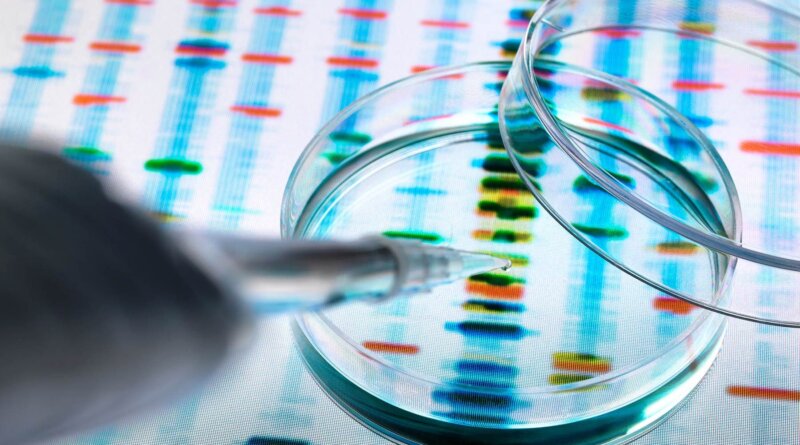Should We Be Testing Everyone’s DNA?
Kelly Kashmer credits genetic testing with saving her life.
In 2014, during a routine medical appointment, a physician’s assistant began asking questions about her relatives and their experiences with cancer. As she mentally climbed her family tree, she recalled her grandmother on her mother’s side, and an aunt, had both been diagnosed with cancer. The details were fuzzy. (She’d later learn that both had died of ovarian cancer.) An aunt on her father’s side, too. But, she reasoned, they were all older than 60 when they were diagnosed. Kashmer was young – only 31 – and busy.
The PA recommended genetic testing for variations known to be linked to hereditary breast and ovarian cancers. A mutation in a BRCA gene increases a woman’s lifetime risk of breast cancer fivefold, and cancer treatment, in general, is more successful during the earliest stages. Kashmer, who was focused on raising her two smart and spirited daughters, ages 1 and 3, didn’t know anything about mutations, risk, and screening.
“Really, I’d never heard anything other than being in the Target line and seeing an article about Angelina Jolie,” says Kashmer, who lives in Fort Mill, SC. In 2013, the actress, whose own mother had died of breast cancer, announced she had tested positive for a pathogenic BRCA mutation and undergone a double mastectomy and reconstruction.
Kashmer consented, unaware that insurance wouldn’t cover the test. She would later be charged $5,000. “If my insurance company had told me that, I would have said, ‘Don’t run it,’” she says now. She didn’t think much about it at the time: As she left, she threw away the informational pamphlets the PA had given her about genetic risks.
Two weeks later, she learned that she’d tested positive for a mutation in the BRCA2 gene. Two weeks after that, after having what was supposed to be baseline imaging – an MRI and mammogram – she was diagnosed with stage II, triple-negative breast cancer. “I was very active, very healthy, and our lives just got turned upside down,” she says. “I definitely got thrown into the middle of this.”
In hindsight, she regards that genetic test as a warning and a blessing in disguise: Without it, she wouldn’t have had imaging or been diagnosed, or been able to act on the diagnosis, as unwelcome as it was. Her experience raises an interesting question: What if everyone had access to screening, not just for breast cancer but for any treatable disease?
Right now, genetic testing isn’t usually used as a front-line tool in medicine. It may be offered with other screening tools when a person’s family history suggests an increased inherited risk of disease, or after they’ve received a diagnosis. Those data can guide treatment decisions for people with some cardiac diseases. Tumor sequencing has become routine in cancer care because some targeted treatments are linked to particular mutations.
It’s not routinely offered in primary care practice, but some researchers, geneticists, and providers say maybe it should be. Genetic testing, in the future, could be a universal screening tool. As sequencing becomes less expensive and research unearths connections between variations and risk, genetic screening could support a kind of “precision public health” approach to medicine, one that allows anyone – not just those with a diagnosis or with access to tests – to benefit from the tools of precision medicine.
Using precise molecular information to help the population sounds like a contradiction. “Precision public health does seem almost oxymoronic when you look at the terms,” says Laura Milko, PhD, a public health genetics researcher at the University of North Carolina at Chapel Hill’s Department of Genetics. But she and other proponents say genetic testing for harmful mutations with associated interventions – if appropriately combined with other screening tools – suggests an effective way to reach a greater share of the population at risk.
Since 2014, when Kashmer was diagnosed with breast cancer, the cost of genetic testing has fallen to a few hundred dollars, rather than a few thousand. And unlike the case 9 years ago, some insurance plans now cover testing that is recommended by a doctor, though policies vary by company and by state. (And they don’t cover elective, private testing.) These changes have helped increase awareness and access, and advocates argue that widespread use of genetic testing would make it more likely that people who are at risk and don’t know it could take preventive action.
“In order for precision health to be equitable for everybody, it needs to be available to everybody,” Milko says. Even though the cost of sequencing has fallen, “what’s happening now is that ‘healthy, wealthy’ folks are able to access things like genetic testing.” That’s partly because of the cost of the test, which is still at least hundreds of dollars, and partly because of disparities in access to high-quality care. People in some ethnic or racial groups, or with low socioeconomic status, get genetic testing at disproportionately lower rates than wealthy, white patients, which means those at high risk because of inherited genes are less likely to find out. Population-based DNA testing points to a way to remedy disparities in screening rates among people from diverse racial, ethnic, or socioeconomic groups.
At the same time, there’s a wide gulf between the potential and putting the testing into practice. No recommended guidelines or accepted standards exist for population DNA screening programs. Privacy and ethical concerns abound about personal genetic data, and insurance companies lack a systematic way to reimburse costs for the tests.
But the payoff for navigating those challenges, says Milko, would be a boon to public health and a potential decrease in diagnoses of many diseases. “The promise is that it would allow us to screen people pre-symptomatically, ideally implemented in such a way that everyone would have access to it,” she says. But “ideally implemented” remains out of reach at the moment, she says, and the stakes of getting it wrong include stoking distrust in medicine, making health inequalities worse, and causing undue stress to patients. “Right now, we need to look at how to implement this in an ethical and equitable manner, and make sure we’re not jumping off a cliff.”
Filling In the Gaps
Screening guidelines exist for a variety of diseases, but they don’t use DNA. Newborn screenings look for blood-borne biomarkers that reveal genetic diseases. Imaging tools like mammograms and MRI are used to find breast cancer. A colonoscopy can reveal colorectal tumors and precancerous polyps that can be safely removed. Blood tests identify people with high cholesterol, which is linked to a higher risk of heart disease and stroke.
These methods aren’t perfect, and researchers continue to debate their benefits. A positive result on a mammogram, for example, can lead to overtreatment, and roughly half of all women who get regularly screened for breast cancer will have a false positive after 10 years of annual screening. Conventional screening guidelines don’t catch everyone, either: A 2018 analysis of more than 50,000 exomes – the parts of genes that include the code for proteins – found that of the men and women who tested positive for a “known pathogenic” or “likely pathogenic” variation in a BRCA1 or BRCA2 gene, nearly half did not meet the standard guidelines for recommending clinical testing.
Using those guidelines alone, “we would still miss half of these mutations,” says genetic counselor Erica Ramos. She’s now an executive with Genome Medical, in San Diego, and serves on the advisory panel for the National Cancer Institute’s All of Us program, which analyzes health data, including genomic data, from volunteers.
“If you screened everybody for BRCA1 and 2, then you don’t have to worry about the personal and family history for those genes before you test,” Ramos says, adding that those histories are still important for recommending next steps. Breast cancer is one example, but screening guidelines for other, treatable diseases – including other cancers and heart disease – similarly miss a large share of the right patients.
A Rough Road to Realization
A population genetic screening program offers a solution, but widespread use will be rife with challenges, says Ramos. Those begin with figuring out how to reach people. “If we’re going to catch people before they get sick, we have to get it into primary care,” she says. That’s a tall order: Primary care doctors are already often overwhelmed, and they may not be comfortable with the complexities of interpreting genetic testing, she says. Plus, half of people between ages 18 and 49 don’t even have a primary care doctor, according to a Kaiser Family Foundation study.
There’s also the issue of privacy and trust. Amid reports of police using DNA from newborn blood draws for criminal investigations and security breaches in companies that do genetic testing, people may worry about the safety of their own data. Or how it might be used. Kashmer, in South Carolina, discovered she wasn’t eligible for a life insurance policy after the genetic test turned up a BRCA mutation, for example. That’s not unusual: Although federal law prohibits medical insurers from basing coverage decisions on genetic tests, life insurance companies can request genetic information from potential customers or from their medical records.
Another issue is when to offer testing, and what genes to test for. “We want to understand who’s at risk for certain conditions that are highly actionable, which means there’s something we could do today to reduce risk,” says Noura Abul-Husn, MD, an internist and medical geneticist from the Icahn School of Medicine at Mount Sinai, in New York City. She also recently joined 23andMe, a consumer gene testing company, to help develop ways for the company to connect consumer genomics with clinical care.
Knowledge about potentially harmful mutations is most useful if it’s connected to a clinical action, says Abul-Husn. The CDC has identified three conditions that have genetic tests available, treatment options based on those results, and rigorous evidence of a benefit. They are hereditary breast and ovarian cancers, Lynch syndrome (which increases a person’s chance of many cancers), and familial hypercholesterolemia (which increases a person’s chance of a heart attack at a young age). Early intervention for these conditions, says Milko, has the best chance of success for preventing life-threatening complications.
Glimpses of the Future
Milko is working on a project, funded by the National Human Genome Research Institute, to develop an age-based genomic screening approach. “We would add it to routine health visits for appropriate ages for intervention,” she says. That means not screening for diseases, for example, that typically don’t show up until adulthood. The goal, she says, would be to find a testing schedule that aligns with the best time to step in to prevent a disease. And as new treatments become available for other conditions detectable by mutations, she says, the number of tested mutations will grow.
Other projects are also working out the details for DNA screening programs. Those include a roadmap for a genomic screening program for healthy adults, published by the National Academy of Medicine in 2018, and a clinical trial looking into the use of whole genome sequencing in newborn screening. (Milko says she wholeheartedly supports the findings of that paper, which suggest that while population screening has tremendous potential to detect genetic risk for inherited conditions in healthy adults, it’s premature to deploy large-scale programs without more research. “Newborn screening works extremely well, and we don’t want to bring in genomic sequencing if it unnecessarily makes parents uncomfortable.”)
Kashmer, in South Carolina, has taken a grassroots approach to increasing access and knowledge about screening. After her treatment, she launched NothingPink, a nonprofit breast cancer advocacy group focused on awareness of genetic testing for cancer. In the last few years, it has successfully advocated for better inclusion of cancer history questions on medical intake forms, and for the state’s Medicaid program to cover BRCA mutation testing. (South Carolina was one of the last three states without coverage.)
It has also created a community where women with a harmful mutation can connect with others who have had to wrestle with tough decisions. “We talk about family planning, we talk about life insurance,” Kashmer says. They discuss both practical and intimate issues.
“These women connect, and I don’t think that these conversations were being had 20 years ago,” Kashmer says. “But it’s a beautiful thing that now we are open to talking. It’s our life, and it’s a real thing, and we just want to be there for the preschools and the proms and the graduations.”




